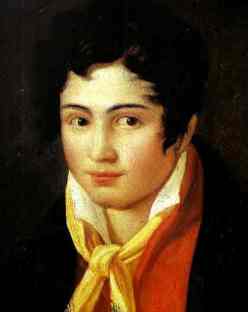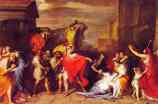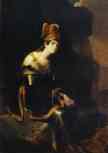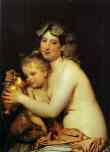Feodor Bruni Biography

Feodor (Fidelio) Bruni was born in Milan, Italy, into the family of Antonio Bruni (1767-1825), painter and sculptor. In 1807 Antonio Bruni, taking all his family, moved to Russia, where he stayed and worked until his death. In St. Petersburg the name Antonio was russified to Anton Osipovich Bruni, you can see his self-portrait here. His son Fidelio, russified as Feodor Antonivich, made a serious career in Russia. Already in 1809 little Feodor was admitted to the school of the Academy of Arts; then he studied in the Academy in the studio of professors A. E. Yegorov and V. K. Shebuyev, and graduated in 1818. In 1820 by the invitation of Princess Zinaida Volkonskaya, writer and patroness of arts, he went to Italy. Death of Camilla, Sister of Horatio brought him his first success. In this work, fulfilled in the tradition of classicism, there are some traits of romanticism. Especially close to romanticism were his following works Portrait of Princess Zinaida Volkonskaya in a Costume of Tankred (1820-22), Bacchante Giving Wine to Cupid. (1828). Bruni could have chosen the new trend of romanticism in art, but he preferred to remain on the positions of classicism. The professional skills of the young artist were highly appreciated and he got commissions from the Academy for copying frescos by Raphael in the Vatican. Simultaneously he started work on his own big painting on the subject of The Brazen Dragon.
In 1836 he returned to St. Petersburg, where he and Karl Brulloff were appointed the professors of the Academy.
In 1837 Bruni executed the portrait of Alexander Pushkin in the Coffin, which was multiplied in lithographs and became widely popular. In 1838 Bruni returned to Italy to continue his work on The Brazen Dragon. The finished painting was brought to St. Petersburg in 1841. The skill of the master, who had managed to build expressive composition with multiple figured on a large canvas (565x852 cm), was evident. The picture had big success and was bought for the Hermitage. Nevertheless the painting belonged to yesterday, to the degenerating academism, which fatally determined the dying of Bruni’s big talent.
The artist’s career went on; he received big commissions for the frescos in the Isaac Cathedral (Isaakievsky Cathedral) in St. Petersburg. By 1845 he completed all 25 of the commissioned cardboards, executed several of the frescos himself, and he supervised the carrying out of all the rest frescos. In 1855 Bruni became the Rector of the Academy and gradually dropped painting. Being an ardent champion of academic principles in art he became less and less popular among the students and democratic-minded professors. In 1871 he left the Academy and his last years spent in full isolation.
Bibliography
Russian Historical Painting. by M. Rakova. Moscow. Iskusstvo. 1979.
Paintings of the 18th-early 20th centuries from the Reserves of the Russian Museum. by K. Mikhailova and G. Smirnov. Leningrad. 1982.
- Death Of Camilla, Sister Of Horatio.

1824. Oil on canvas. The Russian Museum, St. Petersburg, Russia. Read Note.
- Portrait Of Princess Zinaida Volkonskaya In A Costume Of Tankred.

1820-22. Oil on canvas. The Russian Museum, St. Petersburg, Russia. Read Note.
- Bacchante Giving Wine To Cupid.

1828. Oil on canvas. The Russian Museum, St. Petersburg, Russia. Read Note.